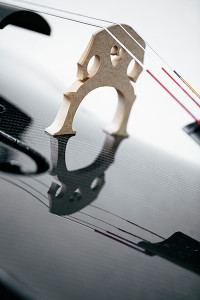Carbon & String Instruments
The major pros for carbon in relation to natural wood:
 Carbon is three times heavier than wood based on its density, but three times stiffer than wood: Thinner wall thicknesses are possible
Carbon is three times heavier than wood based on its density, but three times stiffer than wood: Thinner wall thicknesses are possible- Carbon transmits sound three times faster than wood
- Carbon has less inner damping
- Carbon is not prone to weather effects such as moisture, heat, cold
- Carbon, in regard to its fiber properties, can be processed much more precisely
- Carbon is much more robust mechanically than wood (risk of damage)
- Carbon and fatigue: While metals experience a so called “Giga-Cycle-Fatigue,“ which results in a break after millions of load changes, carbon fiber is free from fatigue failure.This is valid for real loads, e.g., in racing sports, therefore much more for micro vibrations of the instrument corpus caused by playing.
Summary:
Due to the aforementioned properties, especially highly innovative fiber components and their intelligent layering, the response of a Ricci Carbon Instrument is very quick, the dynamic range wide and the overtone-rich sound is brilliant and focused, but still warm.
